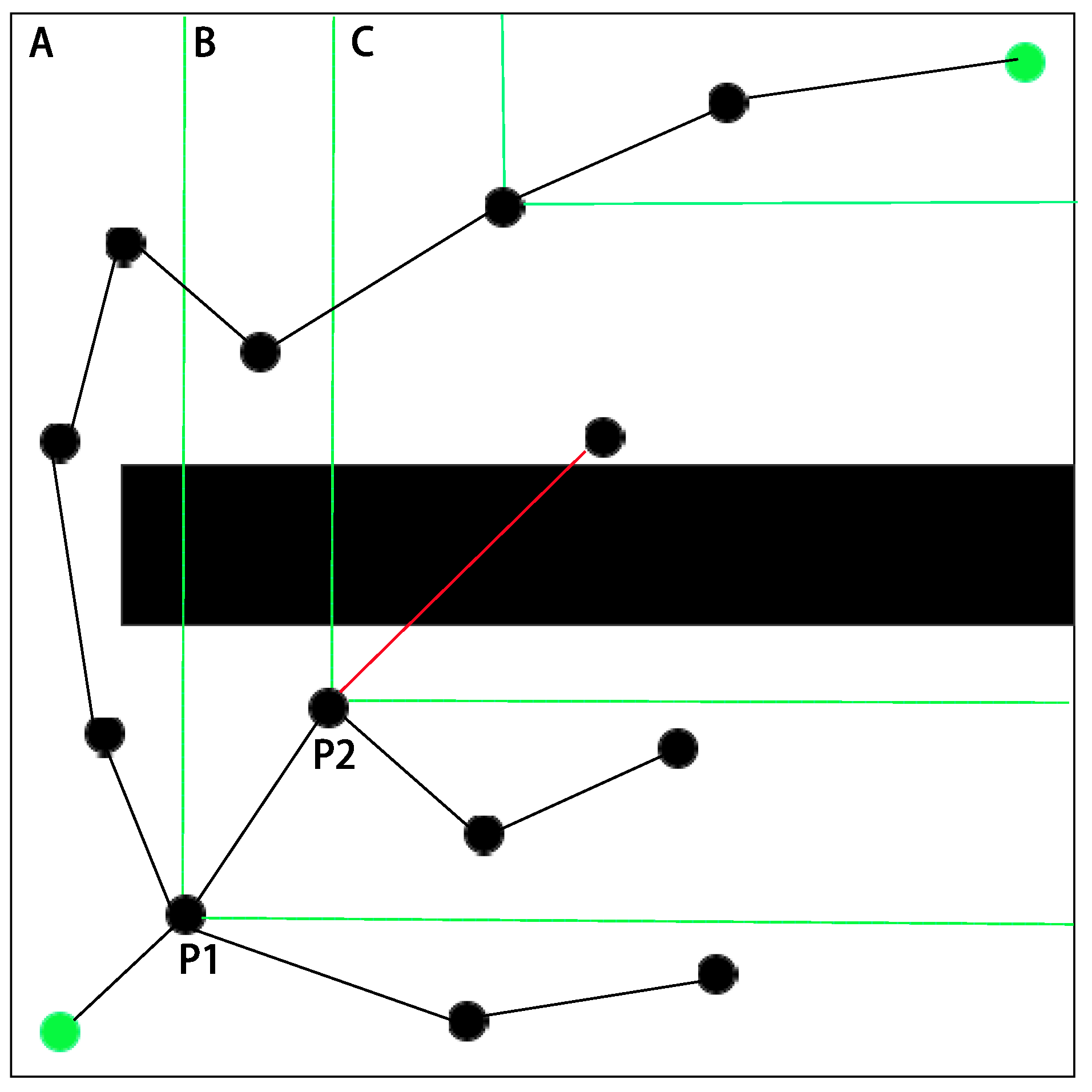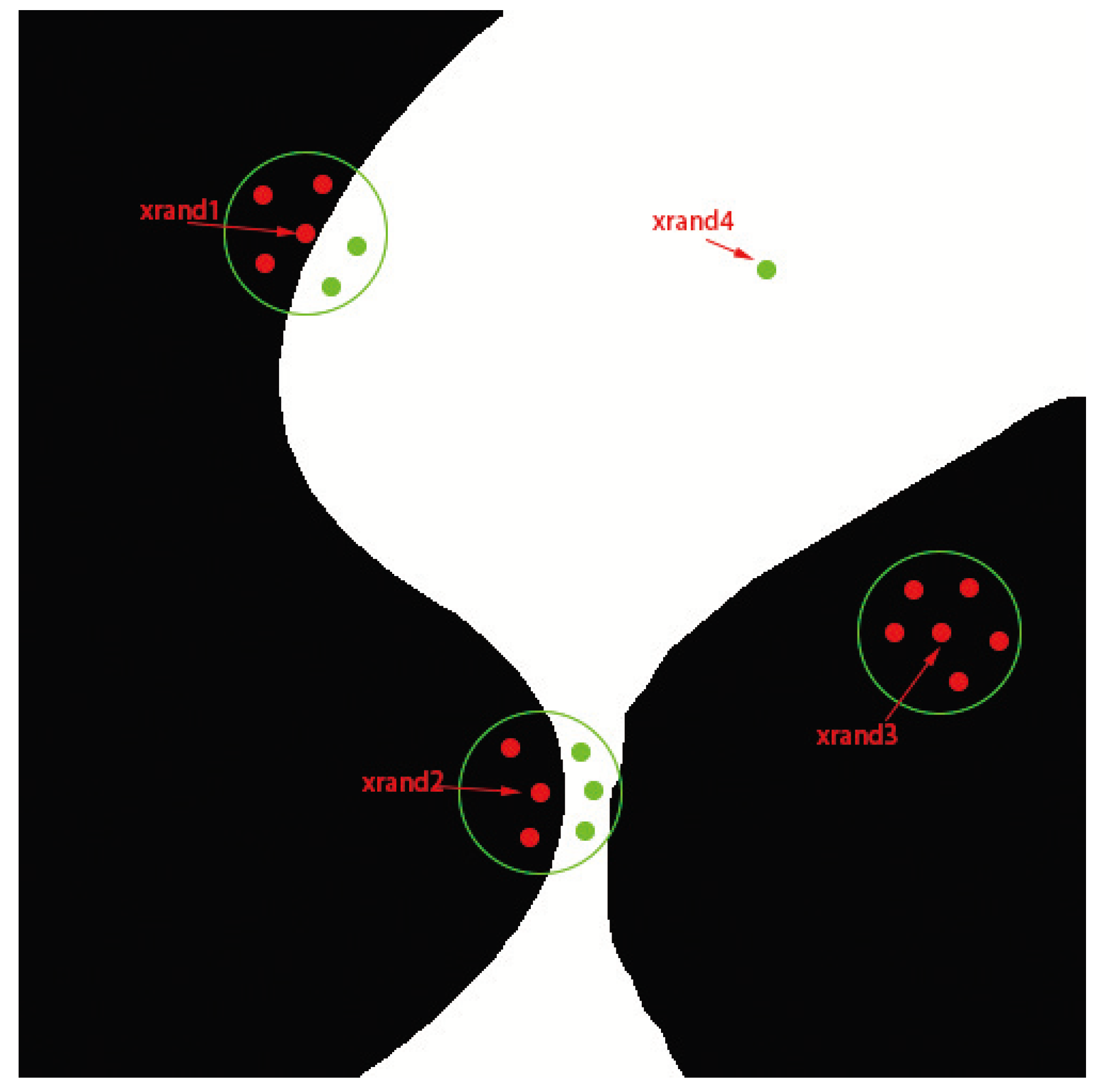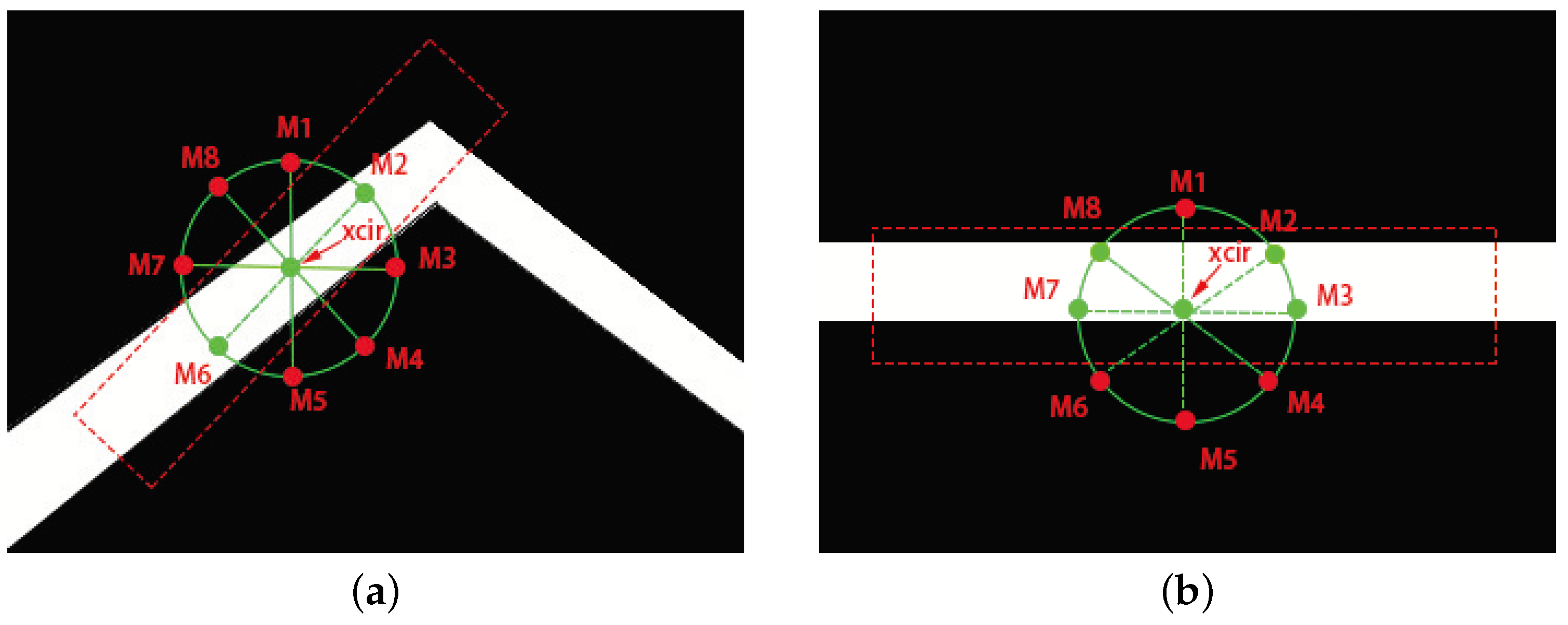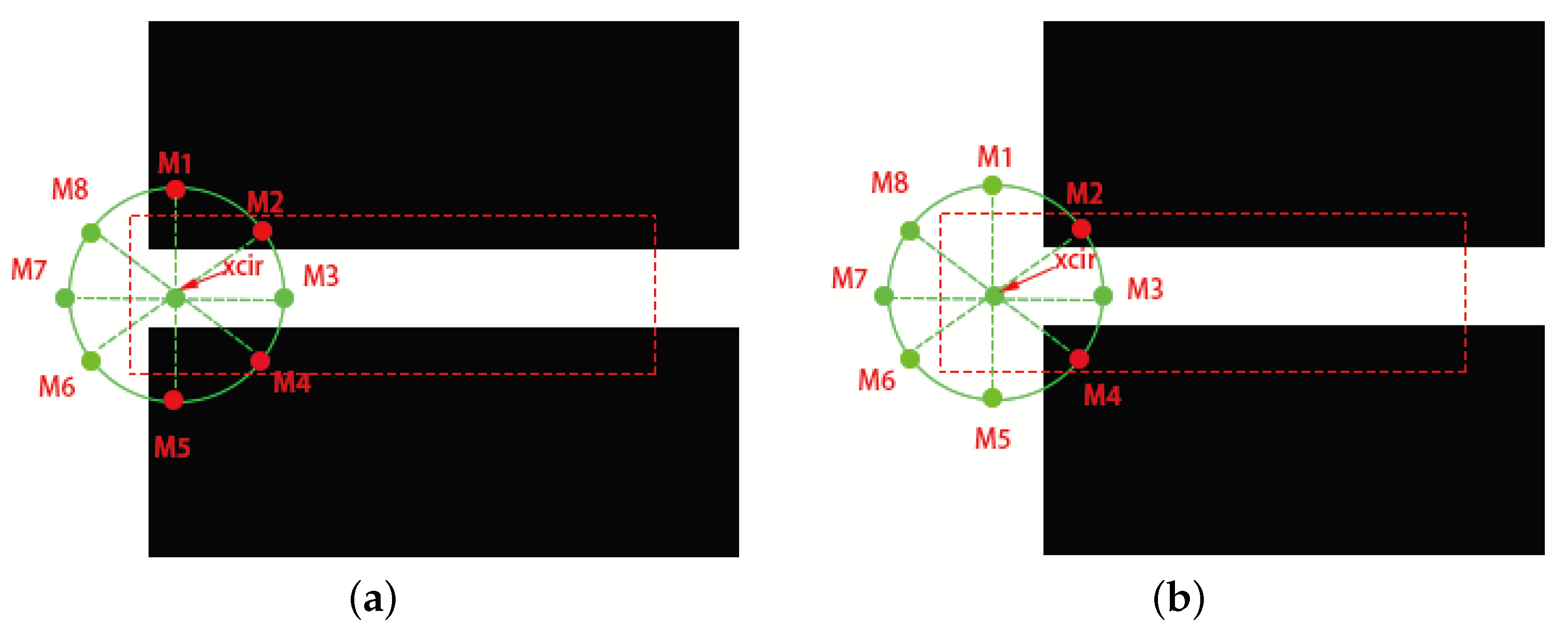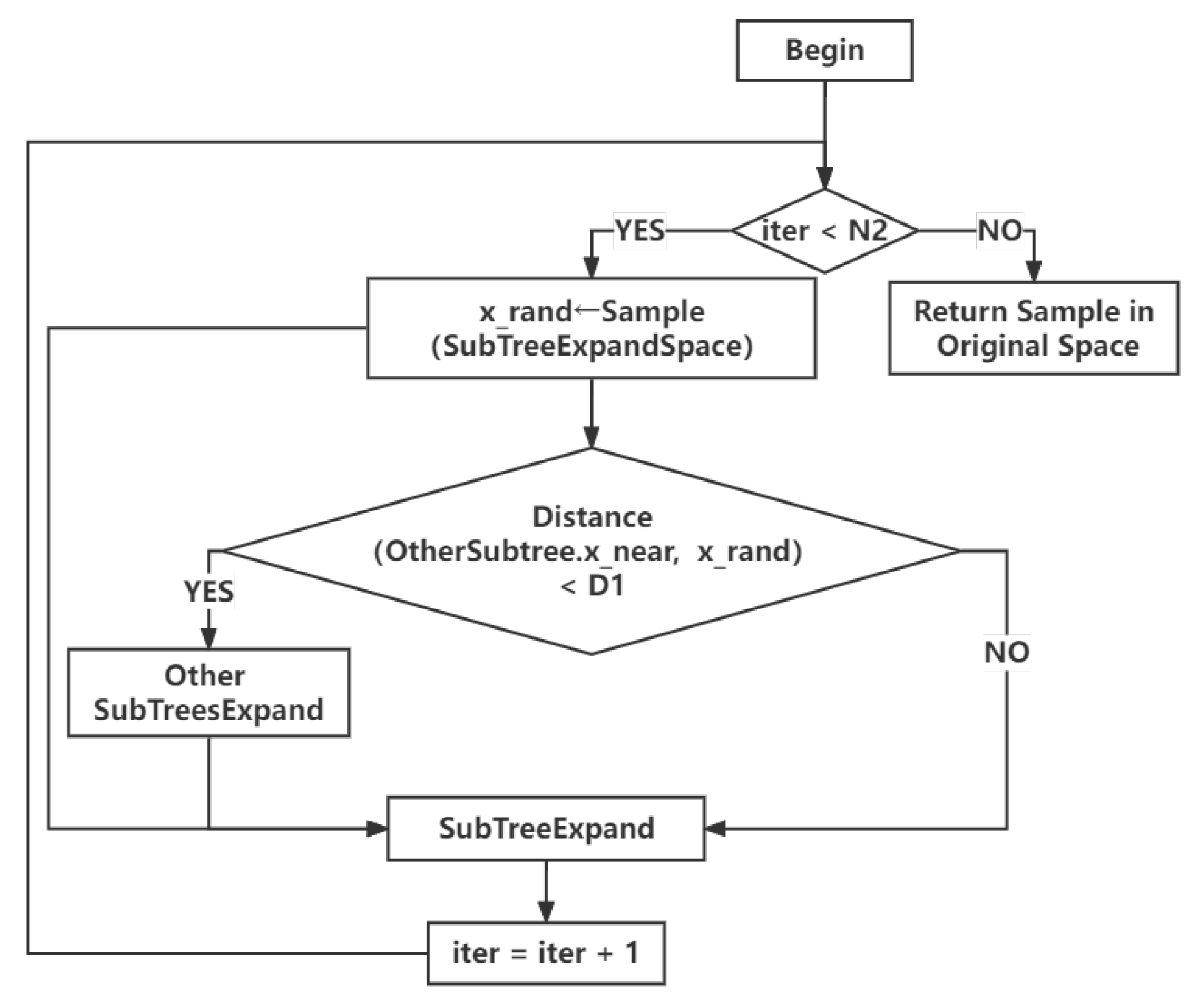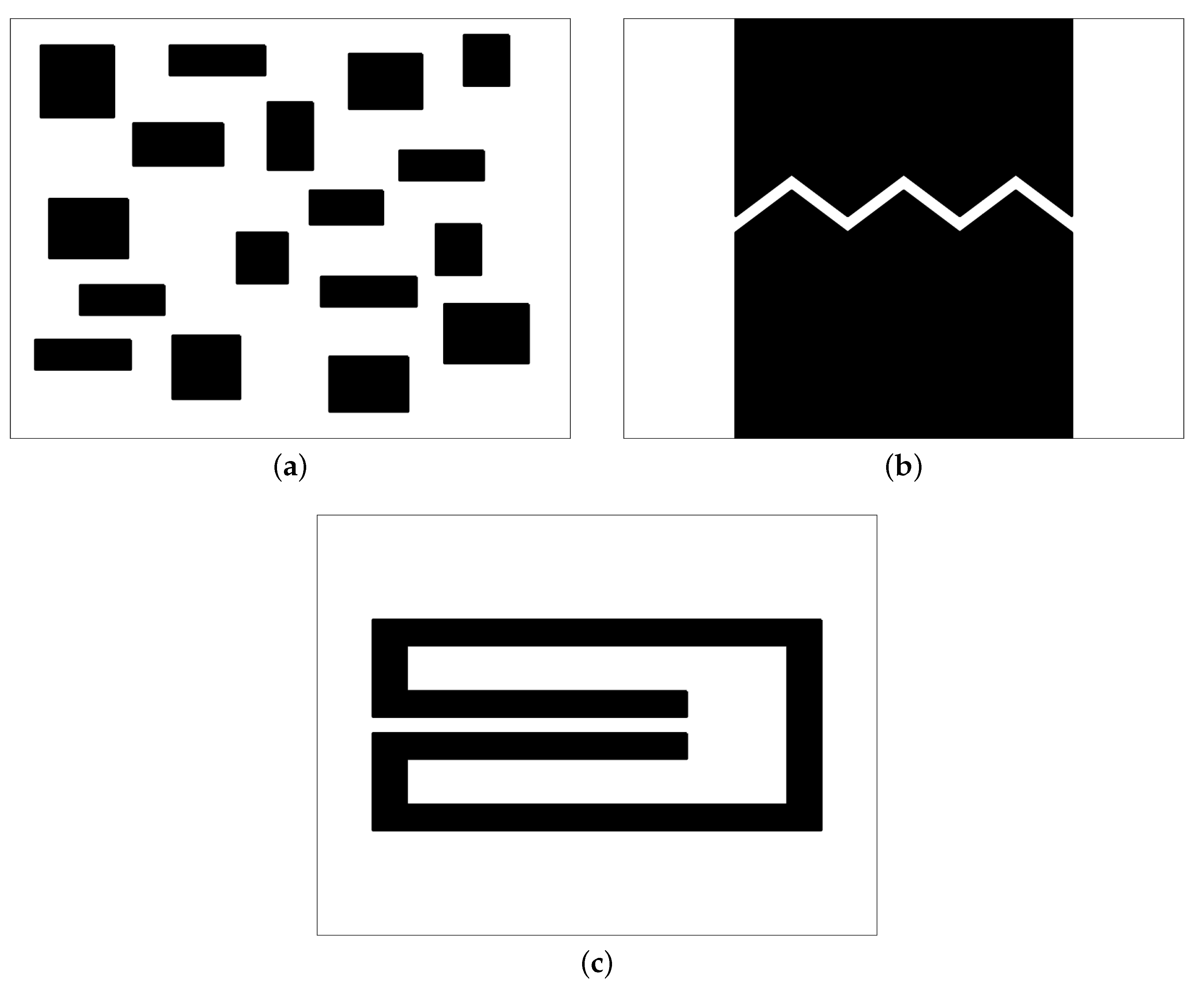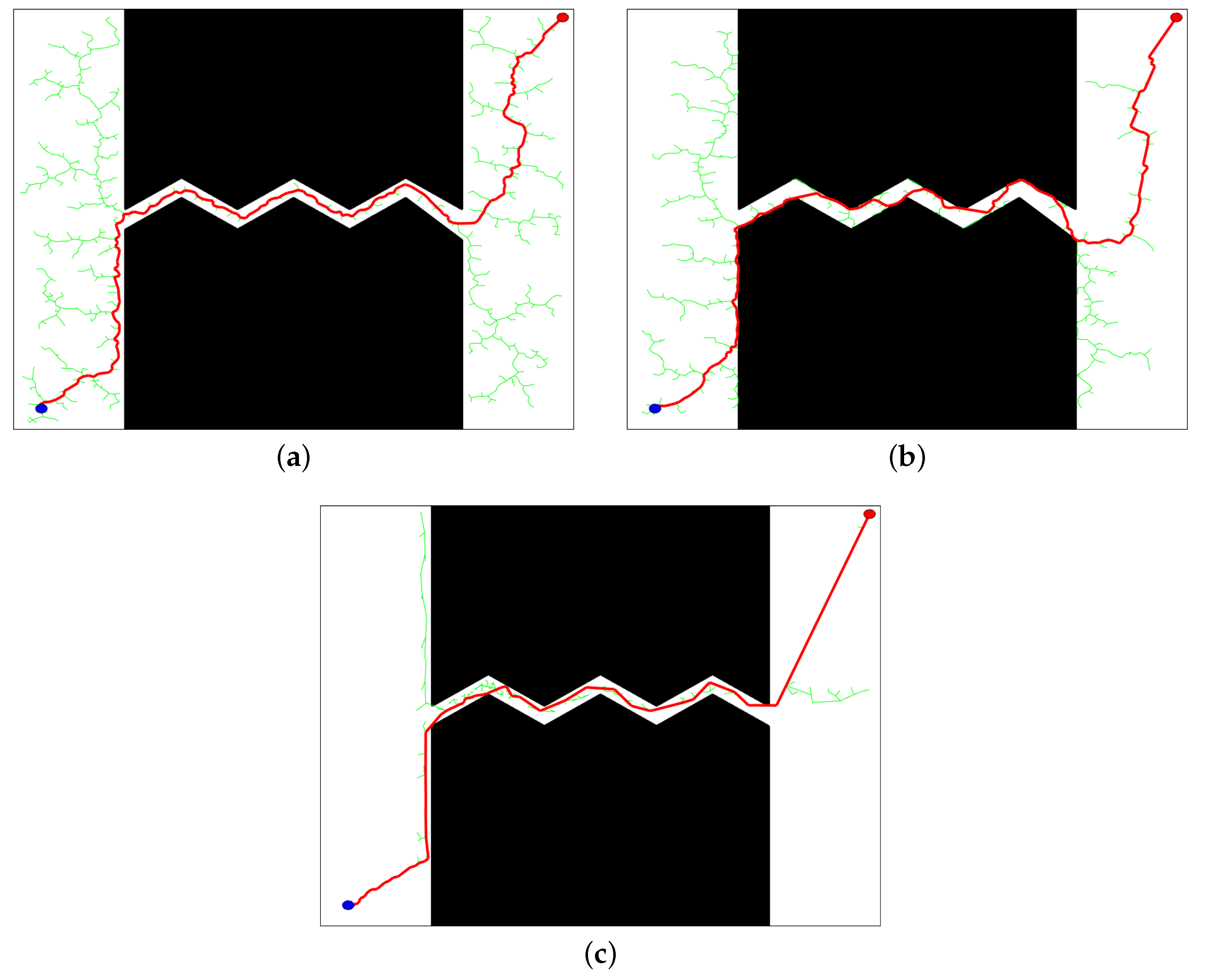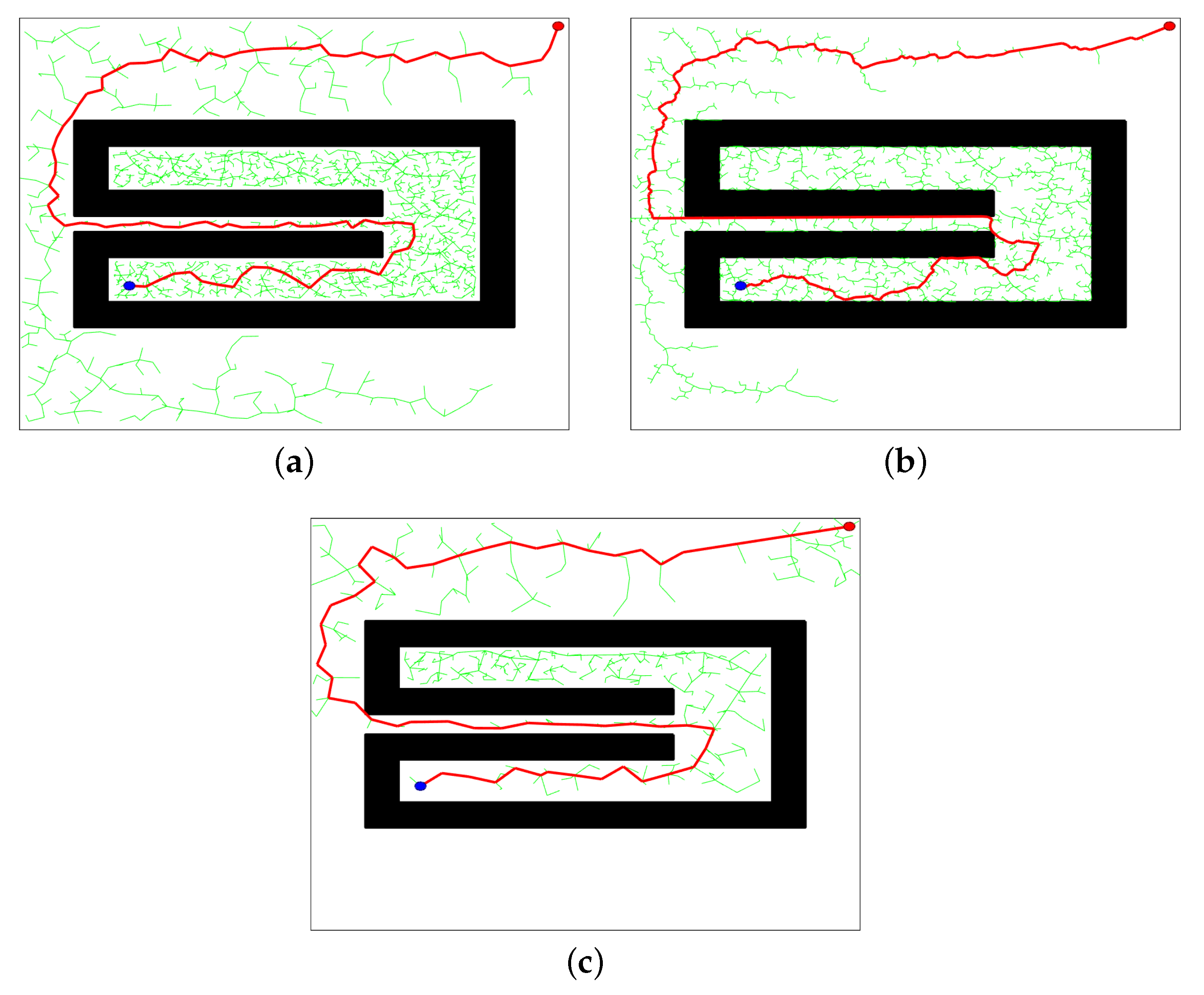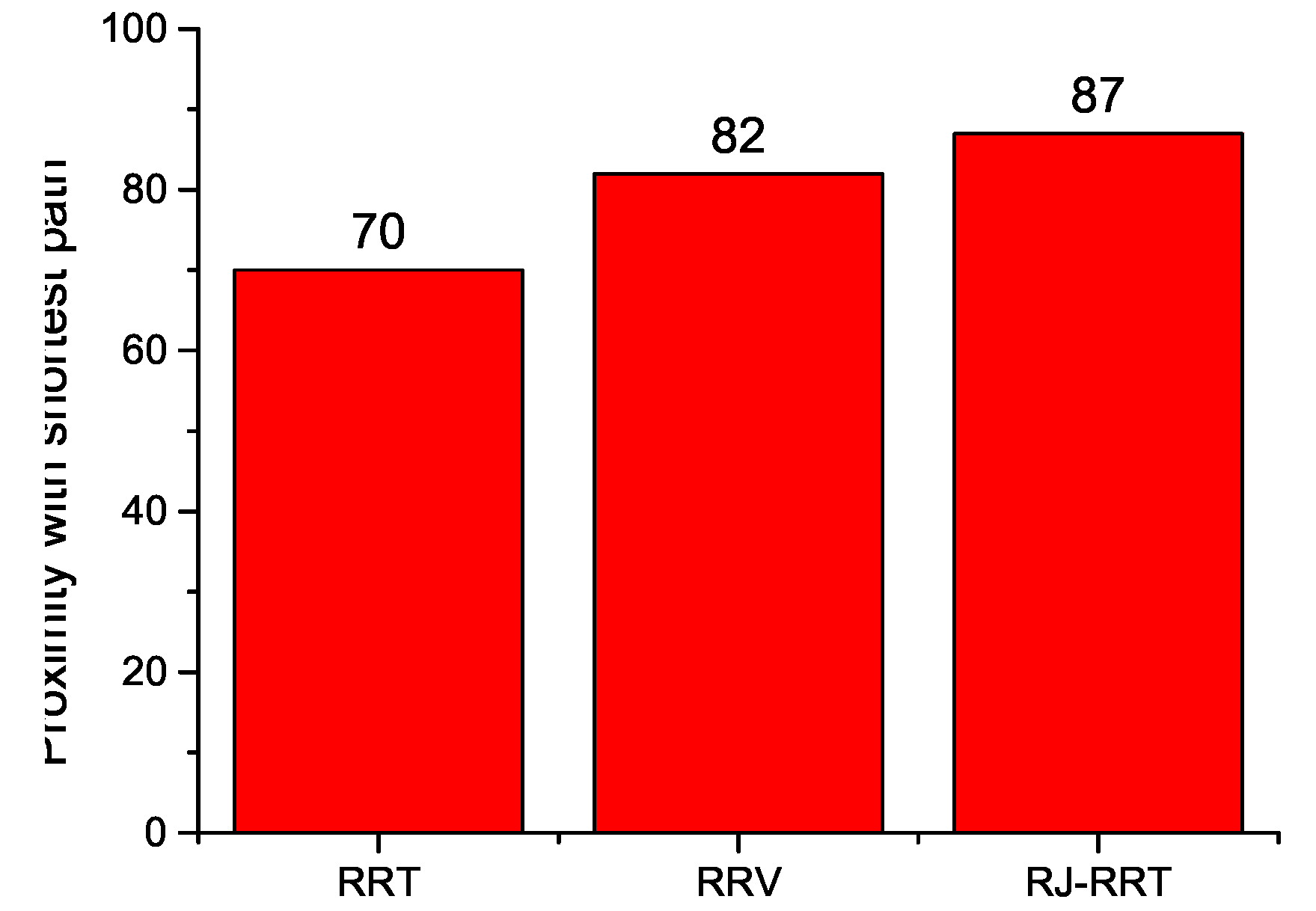1. Introduction
With the rising use of applications such as unmanned aerial vehicles (UAV), autonomous driving, and mobile robots, path planning as an essential part of their technology have long been a research hotspot of scholars [
1,
2]. The main task of path planning is to find an optimal or sub-optimal path from the initial configuration to the goal configuration in the configuration space according to specific performance criteria, such as path length, planning time, and whether the vehicle kinematics are satisfied.
Among many types of algorithms, the graph-based search method represented by A* [
3] and Dijkstra’s algorithm [
4] divides the configuration space mapped from the real environment into multiple grids according to the size of the resolution and then uses the graph search method to find feasible paths. The resolution size has a decisive impact on this type of algorithm’s performance. An overly complex and sizeable real environment often causes an exponential increase in computing time and memory usage [
5]. As another important class of planning algorithms, sampling-based planning algorithms, represented by RRT [
6] and Probabilistic Road Map (PRM) [
7], simplify the configuration space by random sampling. Therefore, they do not require complex geometric modelling and perform better in high dimensions or large environments. Probabilistic completeness guarantees that if at least one feasible path exists, the probability of this class of methods finding the path will be 1 [
8,
9].
Although sampling-based methods have many advantages for path planning, the performance of such algorithms still has challenges when the configuration space contains multiple narrow passages [
10,
11]. As a single-query, RRT plans a path by constructing a random tree extending from the initial configuration to the goal configuration by continuous random sampling. As a multi-query, the PRM needs to generate several random sampling points at the preprocess stage and then connect these points to each other to form a connectivity graph, thus capturing the configuration space’s connectivity. Due to the special property of random sampling, both RRT and PRM are affected by the volume limitation of free space in the random sampling process. Specifically, the branches generated when RRT constructs a random tree are almost impossible to expand in narrow passages, and PRM is difficult to generate random sampling points in the collision-free configuration space with small volumes, thus affecting the construction of connected graphs. To solve the problem that the sample-based algorithm has insufficient planning ability for narrow passages, scholars have given many solutions. For PRM, in [
12], the author proposes an extended-retract map that makes the sampling points all fall on the central axis of free space. In [
13], the author proposed a strategy based on Gaussian sampling. This strategy will increase the sampling points located at the boundary between the obstacle and the free space and eventually generate many sampling points around the obstacle. However, it is not considered that the sampling point is around the obstacle but not necessarily inside the narrow passage. In [
14], the author proposes a bridge connection test method to detect narrow passages. In this method, a bridge is built by sampling points located on two different obstacles. If the midpoint of the bridge is in free space, it means that it has passed the bridge test. Obviously, narrow passages make it easier to build such bridges. In [
15], the author uses an artificial potential field to make the sampling point located on the obstacle move to free space under the action of repulsive force. In [
16], the authors coordinately map both the obstacle space and the free space at the same time, increasing the connectivity of the graph inversely through failed connections.
For RRT, since RRT is more goal-oriented than PRM, it is planning a path while constructing a tree, which makes the improvement of RRT have greater potential. In [
17], the authors propose a Voronoi bias-based planner and improve the sampling strategy according to the visibility of the regions by nodes in the tree. In [
18], the authors regress the sampling points located on the obstacle so that the tree can expand around the edge of the obstacle, thus ensuring the exploration inside the passages. In [
19], the author reduces the total number of samples by rejecting nodes located in the repeated sampling area and proposes a random steer strategy for the narrow passage area, as well as the fusion and adjustment of the path to make the path close to the optimal path. In [
20], the authors use a simple heuristic to generate additional subtrees in the configuration space and control the expansion of the subtrees through parameters. In [
21], a modified bridge test is used to identify narrow passages and relies on multiple subtrees to explore narrow passages. In [
22], the author balances the exploration of global and local random trees through Markov chains. In [
23], the authors use PRM globally and rely on special sampling points to activate RRT and use RRT to explore the complex environment. Based on this idea, RRT can be combined with various variants of PRM.
In particular, with the development of machine learning methods in recent years, learning-based path-planning methods have been extensively developed. In [
24], for dynamically changing environments, the authors build a predictive model using Support Vector Machine (SVM) to capture the connectivity of narrow passages. In [
25], the authors learn by analyzing the density of samples around special regions, using semantic information to guide the distribution of sampling points in random sampling. In [
26], the authors model the expansion of random trees as a multi-armed bandit problem and learn action values through reinforcement learning. In [
27], the author uses a large number of asymptotically optimal paths planned by A* as a dataset to train convolutional neural network (CNN) model, which can predict the optimal path on the map and guide the distribution of sampling points. In [
28], the authors perform local sampling around the sampling point that are difficult to expand, and by performing principal component analysis (PCA) on these local sampling points, the local surrounding environment is divided into narrow passage entrances, narrow passage interiors, and obstacle edges, so random trees can climb obstacles in different environments like vines to expand. This method has achieved good results in the environment with narrow passages. However, due to its dependence on the environment, the performance is slightly worse than RRT in an environment with many obstacles but no narrow passages.
In addition, when solving the problem of narrow passages, the above methods mostly ignore the randomness of whole configuration space sampling, which often leads to part of sampling points in space that are not helpful for the final path construction so that increasing the total planning time and wasting memory resources. This paper proposes a new planning algorithm based on the RRT named Reduce-Judge RRT (RJ-RRT). Specifically, the new algorithm includes two improvements: firstly, based on the greedy idea, a sampling strategy is proposed to reduce the sampling space to the goal area gradually. Secondly, a new method of environment judgment is proposed, when a narrow passage is identified, it can be explored by subtrees expansion inside the passages. The improved environment judgment method only needs a straightforward calculation to determine the environment around the current sampling point. Both strategies improve planning efficiency. On the one hand, random sampling points are used to reduce the sampling space to avoid random tree expansion in space that does not help with path planning. On the other hand, random sampling points are used to detect the surrounding environment, and the subtree of narrow passages helps the random tree expand in the configuration space that is difficult to explore. The results show that the algorithm has good adaptability to various environments, and can greatly reduce the planning time and memory usage.
The rest of this paper is outlined as follows.
Section 2 formally defines the path planning problem and introduces the preconditions of the proposed algorithm.
Section 3 explains the RJ-RRT method proposed in this paper.
Section 4 provides the results and evaluation of the simulation experiments.
Section 5 concludes this paper and discusses future research directions.
2. Background
This section formally defines the problem that path planning needs to solve and introduces algorithms such as Basic-RRT.
2.1. Problem Definition
Let be the the configuration space of the path planning problem, where , . Let be the obstacle space, which is an impassable space, and denotes the obstacle-free space as , which is a passable space. and are the initial configuration and the goal configuration, respectively, and the goal region is defined as a circle with radius r: . A path is defined by continuous function , and , . If the path is feasible, then for all .
The path planning problem is to find a feasible path. Problem 1 defines the feasibility problem of path planning.
Problem 1 (Feasible Path Planning) Given a configuration space of planning problem , a free space , an initial state , and a goal region , find a path if one exists. If no such feasible path exists, return failure.
The cost from the initial configuration to the goal region is not necessarily the same each time planning or on each path. Let be the cost function. The optimization problem of path planning is to find the path with minimum (non-negative) path cost. Its formal expression is given by Problem 2.
Problem 2 (Optimal Path Planning) Given a configuration space of planning problem , a free space , an initial state , a goal region and cost function c. Find a feasible path , such that .
The path planning algorithm usually takes some time to plan the path. Let be the set of times it takes to find a set of paths. Problem 3 defines finding the best path in Problem 2 in the least amount of time possible.
Problem 3 (Fast Path Planning) Minimum time required to plan the Optimal Path.
2.2. Basic-RRT
The Basic-RRT algorithm is described in Algorithm 1 and the Basic-RRT is the basis of RJ-RRT, an underlying tree data structure is maintained in Basic-RRT. As shown in
Figure 1. Firstly, Basic-RRT creates a tree rooted at the
(Line 1 in Algorithm 1). In each subsequent iteration,
is obtained by randomly sampling in the configuration space
X, traversing the existing nodes in the tree, selecting the node
closest to
, and generating
through the steering function with a certain expand size (Lines 3–5 in Algorithm 1). If the edge
is not located in
, then
is added to the tree with
as the parent node, and the edge
will be recorded (Lines 6–8 in Algorithm 1). When
is within the range of
, the planning is ended, and the tree is returned. The return fails when the time-out or the number of iterations is exceeded (Lines 9–11 in Algorithm 1).
| Algorithm 1 Basie-RRT |
- 1:
- 2:
fori = 1 to n do - 3:
- 4:
- 5:
- 6:
if then - 7:
- 8:
- 9:
if then - 10:
return - 11:
end if - 12:
end if - 13:
end for
|
RRT-Biased [
29] is an efficient method to improve RRT. By the premise of a certain probability, the
is set as the sampling point so that the tree can expands faster to the goal area. In Algorithm 2, given a brief description of RRT-Biased.
| Algorithm 2 Biased-RRT |
- 1:
- 2:
ifthen - 3:
- 4:
else - 5:
- 6:
end if
|
In this paper, the tree is rooted at denoted as main tree. The rest of the trees denoted as subtrees.
4. Simulation and Result
In this section, to evaluate the performance of the proposed algorithm, RJ-RRT is compared with Basic-RRT and RRV through a series of experiments. Simulation experiments were tested in three groups of different environments. As shown in
Figure 7, three representative maps are designed in two-dimensional space: complex environment (containing many obstacles), narrow passage, and bug trap environment. The map size of each environment is 10*10. The initial configuration in the first two groups is
, the last group’s initial configuration is
, and the goal configuration uniformly is
. The black area represents obstacles, the green line represents the expansion state of the random tree, and the red line represents the final planned path. Each set of experiments is performed 50 times to collect experimental data. In order to clearly describe the differences in the performance of different algorithms, the average and maximum and minimum execution times of different algorithms in 50 experiments were calculated, and the number of generated nodes was used to reflect the memory usage. The number of collision detections for RRV and RJ-RRT includes additional nodes required for environmental judgment. All-time units are seconds. All algorithms use Gilbert–Johnson–Keerthi (GJK) [
30] for collision detection, and the maximum number of iterations is 50,000. To speed up the planning, the three algorithms uniformly set the sampling probability in the goal space as 0.1. The expand size in the first two sets of experiments was 0.1. In our RJ-RRT, R1 is set to 0.5, N1 is set to 15, R2 is set to 0.7, L1 is set to 3, L2 is set to 1.5, and D1 and D2 are set to 0.7 and 0.5, respectively. All experiments were run on Windows 10 with Intel I7-7700, 3.6 Ghz 8 GB RAM processor, and using MATLAB 2019b as a software platform.
4.1. Complex Environment
Figure 8 shows the performance of the three algorithms in a complex environment. When testing the Basic-RRT algorithm, due to random sampling in the entire configuration space, the final generated random tree occupies almost the entire space. However, although the final tree generated by the RRV algorithm produces fewer nodes than RRT, it still expands in a lot of useless space, and PCA takes a lot of time to calculate. The average number of samples required by the RRV to plan a path is 29% less than that of the Basic-RRT, but the final average planning time is 51% higher than that of the Basic-RRT. The RJ-RRT has the best performance in this environment. The experimental results in the figure show that only a few redundant nodes are generated during the sampling process, and the planning time is the shortest. The specific statistical results of the three algorithms are shown in
Table 1. It can be seen that with the setting of the maximum number of iterations, the three algorithms can find the path 100% in the test. In terms of planning time, RJ-RRT saves 87% compared to Basic-RRT, and 92% compared to RRV. The memory consumption of the generating node is 96% lower than that of Basic-RRT and 94% lower than that of RRV.
4.2. Narrow Passage
Figure 9 shows the planning performance of the three algorithms in a narrow passage environment. The experimental results show that when Basic-RRT faces a configuration space containing narrow passages, due to the lack of identification of the particular configuration of the narrow passage, it is not only challenging to find the entrance of the narrow passage but also challenging to expand inside the passage, so successful path-planning usually requires a large number of sampling points and more time. From
Table 2, it can be concluded that, in this environment, both RRV and RJ-RRT perform better than RRT, while RJ-RRT requires the least amount of time and takes the least number of samples, on average 1.276 s, and generates an average of 227 sampling nodes. Compared with RRV, it saves 45% of planning time and 76% of the generation of the number of nodes. This means that the RJ-RRT can quickly plan a feasible path and occupy fewer memory resources for a narrow passage environment.
4.3. Bug Trap
The expanded size also affects the number of iterations and memory usage of the RRT and RRT variants. In RJ-RRT, the magnitude of each reduction in the sampling space is also determined by the size of the random tree expansion. Therefore, to analyze the influence of different expand sizes on the performance of different algorithms, we use 0.1/0.3 as the expand size for discussion in this experiment.
Table 3 and
Table 4 are the experimental data results when the expand size is 0.1 and 0.3, respectively, and
Figure 10 shows the planning performance when the expand size is 0.3. It can be seen from
Table 3 and
Table 4 that RJ-RRT and RRV perform better than RRT in various performance aspects under different expand size settings. When the expand size is 0.1, RJ-RRT is higher than RRV in generating the total number of nodes. This is because the environment in this experimental, the long and narrow trap passage and short expand size lead to multiple
in the RJ-RRT planning process, resulting in the need for multiple fallback and forward operations. These processes increase the number of samples and planning time, so the final performance is not as good as RRV. When the expand size is set to 0.3, since the expand size increase reduces the number of Gap Spaces, RJ-RRT can still plan a path using a smaller number of nodes and a faster time.
4.4. Path Length
During the experiment, there was an additional discussion, due to the improvement of RJ-RRT’s two strategies of greedy space reduction and dependent subtrees exploration, the length of the final planned path is also reduced to a certain extent. Since the main content discussed in this paper is to improve the adaptability of the RRT algorithm in complex environments, especially in the narrow passage, rather than the path length, so only the path length is briefly discussed in this experiment.
Figure 7a is used for the map in this experiment, and the rest of the settings are the same as those described above. RRT, RRV and RJ-RRT were tested 50 times, respectively, and the difference between the average of the planned path length of the three algorithms and the shortest path was compared.
Figure 11 shows the comparison results of different algorithms on path length. It can be seen that the difference in length between RRV and RJ-RRT is not obvious, about 82%, 87% different from the shortest path and they both save much more distance than RRT.

